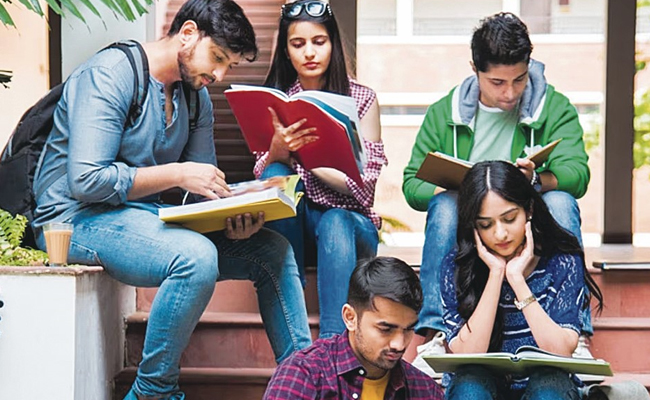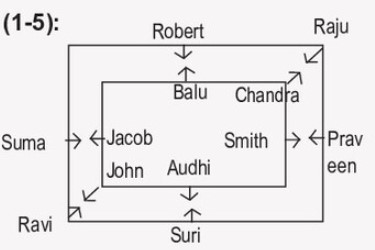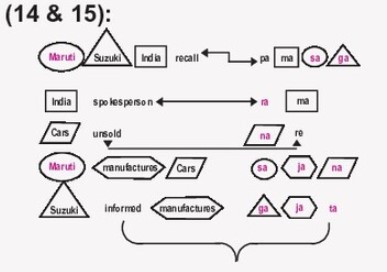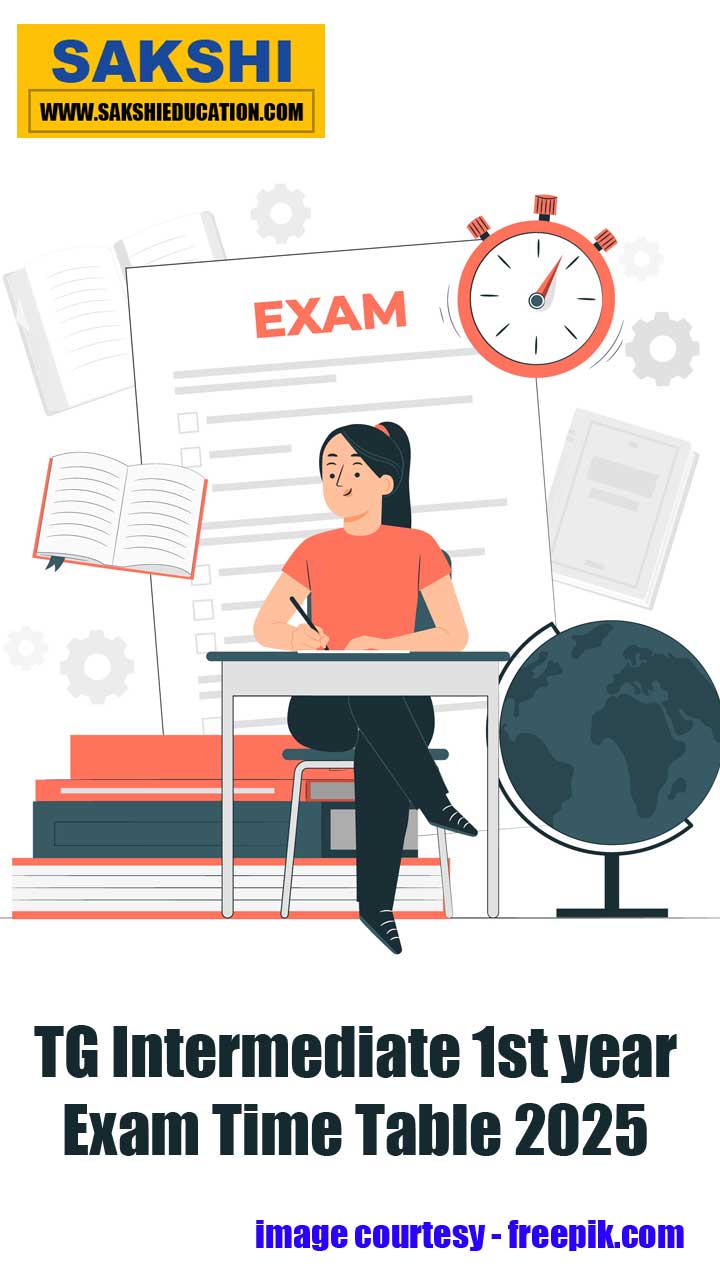Preparatory Questions/Bit Banks for Bank Exams in Reasoning

Model Questions
Directions (Q.No. 1-5): Read the following information carefully and answer the questions that follow:
Twelve friends are sitting in two squares. One square is inside another. Ravi, Praveen, Suri, Suma, Raju and Robert are in the outer square facing inward. Smith, Chandra, Audhi, John, Balu and Jacob are sitting in the inner square facing outward. They all are sitting in such a way that in each square four persons are sitting in the middle of the sides and two persons are sitting on diagonally opposite corners. Each friend in the inner square is facing another friend of the outer square. There are exactly two persons sitting between Ravi and Raju. Balu sits second to the left of Smith. Suri is on the immediate left of the one who is facing Smith. Neither Balu nor Smith faces either Raju or Ravi. Suma is facing Jacob and Praveen is not opposite Suri in the outer square. Raju is not sitting adjacent to Suma. Chandra is not facing Ravi. Between Chandra and John there are as many persons as between Suri and Robert. Ravi sits on any of the corner.
1. Who is sitting opposite Chandra?
1) Robert 2) Praveen
3) Raju
4) Data inadequate
5) None of the above
2. Robert is facing which of the following persons?
1) Balu 2) John 3) Smith
4) Data inadequate
5) None of the above
3. Who is sitting on the immediate left of Suri?
1) Smith 2) Suma 3) Ravi
4) Data inadequate
5) None of the above
4. Four of the five are alike in a certain manner. Select the one which is not similar to the other four.
1) Balu, Suri
2) Smith, Suma
3) John, Jacob
4) Jacob, Praveen
5) None of the above
5. Who is sitting second to the left of John?
1) Smith 2) Balu 3) Jacob
4) Data inadequate
5) None of the above
Directions (Q. No. 6-10): Study the following information carefully and answer the questions given below.
A1, A2, A3, A4, A5, A6, A7 and A8 are eight friends sitting around a circle in one arrangement and in a straight line in another arrangement. While sitting around a circle they are facing outward and while sitting in a straight line they are facing north. One of the immediate neighbours of A8 in the straight line sits opposite A8 in the circle. A5 sits third to the right of A2 in the circle, while fourth to his left in the straight line. A6 and A3 are the immediate neighbours of A2 in both the arrangements, but A3 is not at the extreme ends of the line. The one who sits on the extreme left end sits second to the right of A5 in the circle. A8 is not on the immediate left of A6 in both the arrangements. A7 sits on the immediate left of A8 in the circle, but both are not immediate neighbours of each other in the straight line. A4 sits third to the right of A6 in the straight line. The one who sits on the immediate left of A2 in the straight line is sitting on the immediate right of A2 in the circle.
6. Who among the following sits on the immediate right of A5 in the circle?
1) A4 2) A1 3) A7
4) A3 5) None of these
7. Which of the following pairs sits at the extreme ends of the row?
l) A8, A5 2) A7, A4 3) A6, A7
4) Can't be determined
5) None of these
8. The one who sits third to the right of A3 in the circle is at what position in the straight line with respect to A7?
1) Third to the left
2) Fourth to the right
3) Immediate right
4) Third to the right
5) None of these
9. The person sitting between A5 and A7 in the circle is sitting at what position in the straight line?
1) Extreme left end of the straight line
2) Fourth from the right end
3) Extreme right end of the straight line
4) Third from the left end
5) None of these
10. The one sitting at the extreme left end of the straight line is sitting at what position in the circle?
1) Third to the left of A1
2) Opposite A6
3) Second to the left of A5
4) Immediate right of A8
5) None of these
Directions (Q. No. 11-13): In these questions, a relationship between different elements is shown in the statements. The statements are followed by two conclusions.
Give answer:
1) If only conclusion I is true
2) If only conclusion II is true
3) If either conclusion I or II is true
4) If neither conclusion I nor II is true
5) If both conclusions I and II are true
11. Statement:
W > O > N = D £ E = R
Conclusions:
I. W > D II. R > N
12. Statement:
P < Q = T > N , V < S < P
Conclusions:
I. N > S II. S < T
13. Statements:
L = M > S > G, H < K = G
Conclusions:
I. L > K II. S > H
Directions (Q. No. 14 & 15): Study the following information carefully and answer the following questions:
In a certain code language "Maruti Suzuki India recall" is written as "pa ma sa ga", "India spokesperson" is written as "ra ma", "Cars unsold" is written as "na re", "Maruti manufactures cars" is written as "sa ja na" and "Suzuki informed manufactures" is written as "ga ja ta".
14. What will be the code for "Suzuki recall manufactures"?
1) ga pa na 2) sa ga pa
3) pa ja na 4) ga pa ja
5) ma sa ga
15. What may be the possible code for "Maruti manufactures cars only" in the given code language?
1) sa ja na ha 2) sa ja ta te
3) sa na ta re 4) sa pa ja ta
5) Can't be determined
Directions (Q. No. 16 & 17): In each question below is given a statement followed by two assumptions numbered I and II. An assumption is something supposed or taken for granted. You have to consider the statement and the following assumptions is implicit in the statement.
Give answer:
1) If only assumption I is implicit
2) If only assumption II is implicit
3) If either assumption I or assumption II is implicit
4) If neither assumption I nor assumption II is implicit
5) If both assumption I and II are implicit
16. Statement:
Govt. schools should have uniformity in charging various fees.
Assumptions:
I) The govt. subsidy comes from the money collected by way of taxes from people.
II) The govt. while giving subsidy, may have stipulated certain uniform conditions regarding fees.
17. Statement:
If degrees are delinked from jobs, students will think twice before joining college.
Assumptions:
I) Students join college for getting a job.
II) A degree is of no used for getting a job.
Answers with Explanations

Ans: 1) 3; 2) 1; 3) 3; 4) 3; 5) 1

Ans: 6) 1; 7) 2; 8) 4; 9) 3; 10) 2
11. Given statement:
W > O > N = D £ E = R
Thus, W > D is true. But conclusion II (R ³ N) is not true.
Ans: 1
12. Given statements:
P < Q = T > N ……(i)
V < S < P …….. (ii)
Combining both the statements, we get
V < S < P < Q = T > N
Thus, N ³ S is not true. But
S £ T is true. Ans: 2
13. Given statements:
L = M > S > G ……. (i)
H < K = G ………. (ii)
Combining both the statements, we get
L = M > S > G = K > H
Thus, L > K is true, Again,
S > H is also true. Ans: 5

Ans: 14) 4; 15) 1
16. Assumption (I) is not related to the statement, so it is not implicit. Assumption II is vague.
Ans: 4
17. Job is the main motto of the student. Hence, if degrees are delinked with jobs, students will think twice before joining college. So I is true. II is contrary to it. Ans: 1
Tags
- Reasoning
- bank exams preparations
- Competitive Exams
- Bank Exams
- bit banks for bank exams
- Bank Exams Model Questions
- model and previous questions for bank exams
- Bank Exams Reasoning
- bit banks and previous questions for reasoning
- bank exams in reasoning
- questions and explanation for reasoning
- bank exams in reasoning preparatory questions
- Competitive Exams Bit Banks
- bank jobs
- exams for bank jobs
- subjects for bank jobs exams
- Education News
- Sakshi Education News



















